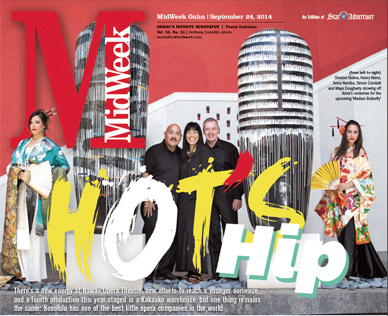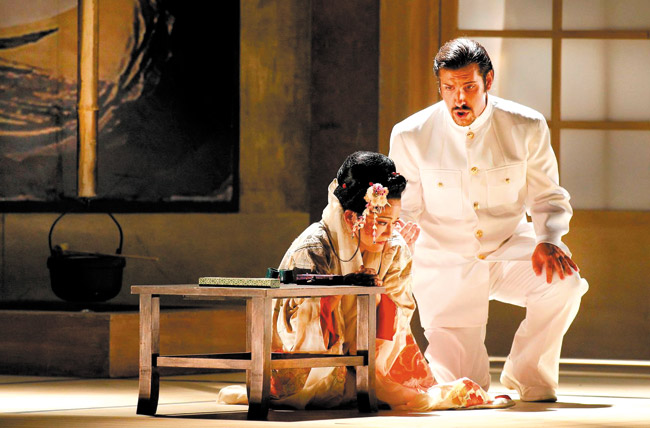HOT’s Hip
Sweeney Todd completes the traditional three-opera lineup, with former HOT executive director Karen Tiller directing. Sweeney Toddis more of a musical than an opera, says Akina, but one that’s very popular with opera singers. It’s an unusual and zesty choice for the lineup, as is a fourth, more contemporary add-on this season in the form of Siren Song. Siren Song will tap into a more youthful pulse, playing outside the normal Blaisdell venue, at a Kakaako warehouse. The idea is that folks can grab a drink or a bite at any of the nearby bars or cafes and then step into a comfortable setting to be entertained. Not only is the location accessible to a more trendy contingent, but so is the story. Siren Songrecounts the true tale of a British sailor who’s been exchanging romantic letters only to discover the object of his affections doesn’t exist. He’s been played. In this age of “sweetheart scams,” everyone can recognize that cautionary theme.
mw-cover-092414-hot-ac-3
“Opera spans about five centuries of human existence, but we tend to cover about 80 years, from mid-19th century to early 20th century,” says Crookall. “We wanted to stretch the repertoire a bit and find something more recent.”
Another way of infusing opera with new energy is through HOT Tuesdays. On the final night of each run, guests convene at Honolulu Club for food, drinks and live music. Following the social merriment, they head out together to the opera.
“People get to meet their friends and be with a group of people their own demographic, and then go across to the opera,” explains Crookall. Mark Oct. 14 for Madam Butterfly’s HOT Tuesday.
One ongoing outlet for ensuring that opera thrives for years to come is to take it to the keiki. HOT’s educational program has elementary and middle school students producing their own operas. We’re talking 6-year-olds not only performing, but also getting involved in creating the storyline, writing their own lyrics that are set to familiar opera tunes, and making costumes and set. Last year, for instance, 120 Waikele Elementary first-graders created their own adaptation of Cinderella. With the guidance of HOT and their teachers, students had Cinderella traveling the world to learn how to win a handsome prince.
“Each class became a different country,” says Crookall, “so Cinderella goes to Japan, and the Japanese sing a song and say ‘give him sushi and he’ll fall in love with you.’ The Thai people say, ‘dance like this and he’ll fall in love with you.’ An American Indian community says, ‘give him moccasin slippers’ … she goes to all these places and each class does their little song.”
The children give the time-worn story a more relevant slant by having the prince become so impressed with Cinderella’s industriousness that he tells her she’s just the girl he’d like to run his kingdom. Likewise, the program instills in keiki a modern appreciation for the classic art form, and nurtures a familiarity in them with opera’s most famous tunes.
Also expanding to a younger age bracket is HOT’s Orvis Opera Studio, which now is cultivating high school students in addition to college-age students. Keeping with the surge of expansion and outreach, members of the studio toured a condensed version of The Mikado last year to 77 schools (16,000 students) on the four main Hawaiian islands. Meanwhile, the full-scale production of Mikado, which played at Blaisdell last season, island-hopped to Maui, involving the formidable feat of transferring 100 cast and company members to Maui Arts and Cultural Center and back all in one day. Crookall has plans to create smaller touring companies in the next two to three years that can perform at theatre houses across the Islands. He’s guided by the very name of the company:
“We’re the Hawaii Opera company, not the Honolulu Opera company,” he points out.
HOT also is reaching upscale niches. A preview to Madam Butterflyhas Anne Namba hosting Project Butterfly, a Sept. 28 brunch and fashion show at Halekulani. Song and fashion will be interspersed with models and opera singers all sporting Namba designs.
Another ultra-chic excuse for dressing to the nines is the “Gorgeously Gothic” black tie opera ball Nov. 8 at The Modern Honolulu, fashioned after Sweeney Todd, which will close the season in April. There are no speeches, just glitz and glamour, food, dance and songs from the show.
Whether introducing new audiences to opera or raising funds, these myriad activities ensure a bright future for HOT. European opera companies receive up to 85 percent of their financial support from their governments, says Crookall, but American arts companies don’t have that benefit. Crookall is courting Hawaii’s youths to get them on stage and in the seats, but the home-run challenge is to turn them into long-term supporters of opera. He refers to his ABC mantra, standing for the three foundational pillars of success: Artistic excellence, Business (income) and Community:
“Artistically, we’re doing incredibly well, which makes it easier to generate income. Community is what makes an arts company really work. You can be fiscally superb and artistically wonderful, but if you don’t engage with the people around you, you’re hopeless.”
Opera has a history in Hawaii. Queen Emma, Queen Lili’uokalani and King Kamehameha IV were all strong proponents of the art form in the 1800s, with a small opera house functioning where the downtown post office now stands. By the ’20s, says Akina, news media predicted that a new thing called cinema would extinguish opera. But with Akina and Crookall at the helm, that’s clearly not the case for HOT.
“We’re doing new things,” says Crookall. “We have a more contemporary look and we’re getting the word out more.
“It’s easier to participate than you’d expect. We just need people to cross the threshold and they’ll have a great time! It’s hard not to.”
For tickets or more information, visit hawaiiopera.org.







